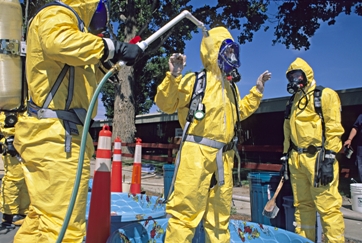
Lest anyone tell you that the phase-out of (non-toxic) incandescent light bulbs will be hassle-free (other than hugely expensive), herewith is the directive from the Environmental Protection Agency for ridding your home of toxic vapor in the event you or a loved one (or relative) breaks the mercury-laden compact fluorescent (CFL) pushed by the government as superior:
- Have people and pets leave the room, and avoid the breakage area on the way out.
- Open a window or door to the outdoors and leave the room for 5-10 minutes.
- Shut off the central forced-air heating/air conditioning system (H&AC), if you have one.
- Collect materials you will need to clean up the broken bulb: 1) Stiff paper or cardboard; 2) Sticky tape (e.g., duct tape); 3)Damp paper towels or disposable wet wipes (for hard surfaces); 4) Glass jar with a metal lid (such as a canning jar) or a sealable plastic bag(s)
- Carefully scoop up glass fragments and powder using stiff paper or cardboard and place debris and paper/cardboard in a glass jar with a metal lid. If a glass jar is not available, use a sealable plastic bag. (NOTE: Since a plastic bag will not prevent the mercury vapor from escaping, remove the plastic bag(s) from the home after cleanup.)
- Use sticky tape, such as duct tape, to pick up any remaining small glass fragments and powder. Place the used tape in the glass jar or plastic bag.
- Wipe the area clean with damp paper towels or disposable wet wipes. Place the towels in the glass jar or plastic bag.
- Vacuuming of hard surfaces during cleanup is not recommended unless broken glass remains after all other cleanup steps have been taken. (NOTE: It is possible that vacuuming could spread mercury containing powder or mercury vapor, although available information on this problem is limited.) If vacuuming is needed to ensure removal of all broken glass, keep the following tips in mind: 1) Keep a window or door to the outdoors open; 2) Vacuum the area where the bulb was broken using the vacuum hose, if available; and 3) Remove the vacuum bag (or empty and wipe the canister) and seal the bag/vacuum debris, and any materials used to clean the vacuum, in a plastic bag.
- Promptly place all bulb debris and cleanup materials, including vacuum cleaner bags, outdoors in a trash container or protected area until materials can be disposed of properly.
- Check with your local or state government about disposal requirements in your area. Some states and communities require fluorescent bulbs (broken or unbroken) be taken to a local recycling center.
- Wash your hands with soap and water after disposing of the jars or plastic bags containing bulb debris and cleanup materials.
- Continue to air out the room where the bulb was broken and leave the AC system shut off, as practical, for several hours.
- The next several times you vacuum the rug or carpet, shut off the AC system if you have one, close the doors to other rooms, and open a window or door to the outside before vacuuming. Change the vacuum bag after each use in this area.
- After vacuuming is completed, keep the H&AC system shut off and the window or door to the outside open, as practical, for several hours.
To avoid breaking a bulb, follow these general practices:
- Always switch off and allow a working CFL bulb to cool before handling.
- Always handle CFL bulbs carefully to avoid breakage: 1) If possible, screw/unscrew the CFL by holding the plastic or ceramic base, not the glass tubing; 2) Gently screw in the CFL until snug. Do not over-tighten; 3)Never forcefully twist the glass tubing.
- Consider not using CFLs in lamps that can be easily knocked over, in unprotected light fixtures, or in lamps that are incompatible with the spiral or folded shape of many CFLs.
- Do not use CFL bulbs in locations where they can easily be broken, such as play spaces.
- Use CFL bulbs that have a glass or plastic cover over the spiral or folded glass tube, if available. These types of bulbs look more like incandescent bulbs and may be more durable if dropped.
- Consider using a drop cloth (e.g., plastic sheet or beach towel) when changing a fluorescent light bulb in case a breakage should occur. The drop cloth will help prevent mercury contamination of nearby surfaces and can be bundled with the bulb debris for disposal.
There’s a much simpler remedy, of course: Repeal the phase-out of Thomas Edison’s gift to mankind.
“Every tiny step forward in the world was formerly made at the cost of mental and physical torture.”
ReplyDeleteCamelia Brown: Absolutely funny story about vacuum. Thanks for tell us.
ReplyDelete